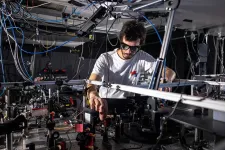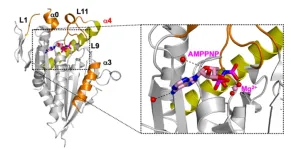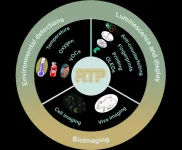(Press-News.org) New knowledge of the genetic factors behind premature delivery and gestational duration has now emerged. Findings presented by a major international study under the aegis of the University of Gothenburg include the ways in which, before birth, the woman’s and the unborn child’s genes have mutually antagonistic effects.
These results, now published in the journal Nature Genetics, enhance the potential for long-term development of drugs to induce parturition (birth) and — even more importantly — achieve the goal of preventing preterm births.
Globally, preterm (or premature) birth is the most frequent immediate cause of death among newborns and children aged up to five years; and the earlier the parturition, the higher the risk. “Preterm birth” refers to delivery before the 37th week of pregnancy. Most births take place in gestation week 39 or 40.
Bo Jacobsson, professor of obstetrics and gynecology at Sahlgrenska Academy, University of Gothenburg, and senior consultant doctor at Sahlgrenska University Hospital, led the study. His previous advances in this area were already acclaimed.
New understanding of mechanisms
The minimal margins in a human birth set us apart from other mammals. A woman’s pelvis barely allows a fully grown fetus to pass through; in contrast, a female chimpanzee’s pelvic passage, for example, has twice the diameter as that of her young.
The process preceding a human birth is thus extremely critical, and to enhance understanding of the processes governing when the onset of labor takes place, it is human beings specifically who need to be studied — in this case, the genetics of the woman and her unborn child.
The present study surpasses its predecessors in size and breadth. This time, some 90 researchers from the Early Growth Genetics Consortium (EGG), an international network, took part. Just over 20 international birth cohorts comprising a total of 279,043 individuals studied, were included.
“The results have given us more routes to understanding how labor is initiated, both at full term and in premature labor. In samples, we were able to identify numerous previously undiscovered genetic variants associated with the timing of parturition, and these provide unmatched insights into the underlying biological mechanisms,” Jacobsson notes.
Maternal–fetal genetic deal
To understand whether gestational duration is determined by the genes of the woman or the fetus, we examined 136,833 cases. These involved either the combination of both parents and their offspring or the woman and her offspring, enabling the effects of the woman’s and the child’s genome respectively to be distinguished with greater precision.
The first author of the study, Pol Solé Navais, is a researcher at the University of Gothenburg’s Sahlgrenska Academy. He describes how the findings support the hypothesis of genetic conflicts between mother and child.
“What we see is that there might be a conflict between the genomes of the woman and unborn child respectively when it comes to the duration of pregnancy. Genetically, the woman’s genes favor earlier onset of labor to expel the child, for her own survival, while those of the unborn child favor extension of the pregnancy to gain weight. So, they reach a kind of compromise deal,” he says.
In the long run, the research has two aims: to develop drugs that can prevent preterm birth, and to mitigate or boost contractions during delivery. According to the researchers, their study results show that studies on human genetics are a good way to find conceivable targets for these drug therapies.
END
Genetics of preterm birth and pregnancy length clarified
2023-04-03
ELSE PRESS RELEASES FROM THIS DATE:
More U.S. prostate cancer patients choosing active surveillance
2023-04-03
The number of prostate cancer patients in the U.S. choosing active surveillance over surgery or radiation has rapidly increased since 2010, rising from 16% to 60% for low-risk patients and from 8% to 22% for patients with favorable intermediate-risk cancers, according to a study published today in JAMA Internal Medicine.
Active surveillance includes actively monitoring prostate cancer for progression, with the intention to intervene with surgery or radiation therapy if the cancer progresses.
It is the preferred treatment option for men with low-risk ...
Double-slit experiment that proved the wave nature of light explored in time
2023-04-03
Imperial physicists have recreated the famous double-slit experiment, which showed light behaving as particles and a wave, in time rather than space.
The experiment relies on materials that can change their optical properties in fractions of a second, which could be used in new technologies or to explore fundamental questions in physics.
The original double-slit experiment, performed in 1801 by Thomas Young at the Royal Institution, showed that light acts as a wave. Further experiments, however, showed that light actually ...
Researchers show lorlatinib is safe and effective for patients with ALK-driven relapsed/refractory high-risk neuroblastoma
2023-04-03
Philadelphia, April 3, 2023—In a significant step for the treatment of neuroblastoma, an international group of researchers led by Children’s Hospital of Philadelphia (CHOP), Winship Cancer Institute of Emory University and the New Approaches to Neuroblastoma Therapy (NANT) Consortium has shown that the targeted therapy lorlatinib is safe and effective in treating high-risk neuroblastoma. The findings, published today in Nature Medicine, have led to a major amendment in a phase 3 Children’s Oncology Group (COG) clinical trial, which has incorporated lorlatinib for newly diagnosed ALK-driven high-risk neuroblastoma, ...
Hidden ice melt in Himalaya: Study
2023-04-03
A new study reveals that the mass loss of lake-terminating glaciers in the greater Himalaya has been significantly underestimated, due to the inability of satellites to see glacier changes occurring underwater, with critical implications for the region's future projections of glacier disappearance and water resources.
Published in Nature Geoscience on April 3, the study was conducted by an international team including researchers from the Chinese Academy of Sciences (CAS), Graz University of Technology (Austria), the University of St. Andrews (UK), and Carnegie Mellon ...
Hannover Messe: Smart films help to make loudspeakers lighter and more energy-efficient
2023-04-03
Professors Stefan Seelecke and Paul Motzki at Saarland University are developing intelligent materials that are opening up new avenues in sound reproduction technology: lightweight loudspeakers that use far less energy than their conventional counterparts, novel shapes for sound and signal generators and applications involving noise cancelling textiles. The basis for these smart materials are ultrathin silicone films that can act as artificial muscles with their own built-in sensors. The research team will be showcasing their new technology at this year’s Hannover Messe from 17 to 21 April (Hall 2, Stand B34).
Ultrathin films may well replace the heavy and power-thirsty ...
LSU Health New Orleans LA Tumor Registry releases 6th Census Tract Cancer Incidence Report
2023-04-03
New Orleans, LA -- LSU Health New Orleans Louisiana Tumor Registry (LTR) has published the sixth report of statewide cancer incidence rates by census tract. The publication, which reports 2010-2019 combined cancer incidence data, found that 81% of the census tracts in Louisiana met publication criteria for all cancers combined. For specific cancer types, fewer census tracts met the criteria. For the Louisiana census tracts meeting the criteria, the incidence rates for all cancers combined and for specific cancer types were compared with the corresponding rates for the entire state. The ...
Anticancer drugs with fewer side-effects: scientists decode the crystal structure of a key cell cycle protein
2023-04-03
Anticancer drugs are pivotal to cancer treatment, but their toxicity may not always be limited to cancer cells, resulting in harmful side-effects. To develop anticancer therapies that have fewer adverse effects on patients, scientists are now focusing on molecules that are less toxic to cells. One such group of drugs is the "kinesin inhibitors." These inhibitors prevent cancer progression by explicitly targeting kinesin motor proteins, which are required for the division of cancer cells. Centromere-associated protein E (CENP-E), a member of the kinesin motor protein, is a promising target for inhibitor therapy, as it is essential for tumor cell replication. However, determining the ...
Researchers reviewed recent progress of organic room-temperature phosphorescent materials towards application
2023-04-03
Organic materials with room-temperature phosphorescence (RTP) emission have attracted extensive attention due to extraordinary properties including long lifetime, large Stokes shift, stimuli-responsiveness, and so on, and show bright prospects in broad fields. However, the energy of the excited state of organic phosphors is easily consumed through thermal radiation and collision deactivation. Therefore, numerous design strategies such as creating a rigid environment through crystallization and supramolecular assembly are employed to improve the luminescent characteristics of RTP materials by restricting nonradiative transition, enhancing intersystem crossing, and so forth. A team ...
American Kidney Fund awards fellowships to researchers focused on barriers to home dialysis and living donor transplants among youth; COVID-19 vaccine booster disparities in the dialysis community
2023-04-03
ROCKVILLE, Md. (April 3, 2023)— Today the American Kidney Fund (AKF) announced the recipients of this year’s Clinical Scientist in Nephrology (CSN) fellowship program, in which promising researchers work to improve the quality of care for people living with kidney disease and promote clinical research in nephrology. Dr. Alexandra Bicki, a pediatric nephrology fellow at the University of California, San Francisco, will be working on identifying facilitators and barriers to home dialysis and living kidney donor transplantation among adolescents and young adults, while Dr. Nivetha Subramanian, a nephrology fellow at ...
SwRI expands hydrogen energy research capabilities with new liquid hydrogen storage tank
2023-04-03
SAN ANTONIO – April 3, 2023 — Southwest Research Institute has installed a large-capacity liquid hydrogen tank to expand its advanced hydrogen energy research initiatives. Leveraging the tank’s capabilities alongside a multidisciplinary research approach, SwRI endeavors to explore technology opportunities and address obstacles related to hydrogen energy research and development.
The SwRI liquid hydrogen storage tank has a capacity of 17,000 gallons and will provide the Institute with a cost-effective, reliable supply of hydrogen ...







